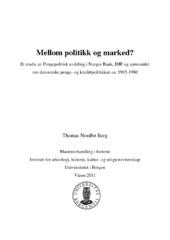| dc.description.abstract | This master thesis is a study of the Monetary Policy Department in the Bank of Norway (BoN), the International Monetary Fund (IMF), and the question of the Norwegian monetary and credit policy around 1965-1980. The main ambition of the project was to study the relationship between the IMF and BoN, both at institutional and at the participant level. There was also a desire to study both international experience, through the economist's participation with IMF's consultations with other countries, and the point of view, and thereby knowledge regimes, the economist's in the Monetary Policy Department expressed in monetary and credit policy issues. In order to study verifiable point of view it here mainly focus on the printed debate, which has been supplemented with interviews when this has been possible. The three angles were examined in two chapters that covered the periods 1965-1973 and 1974-1980. In 1973, the Magnussen Committee submitted its report and expressed a desire to move towards market-determined interest rates. At the same time there was a significant recruitment growth in the bank. Especially in transition between the 1960 and 1970 century, an increasing number of new young economists were employed by the Monetary Policy Department in BoN. This thesis argues that the relationship between the IMF and BoN, both at institutional level and at the participant level, showed that the monetary and credit policy in Norway drew criticism from both the IMF and BoN. The survey of foreign visit showed that economists at BoN could draw experiences from other countries that used other instruments, mainly a flexible interest rate and market operations, than the Norwegian legislation gave access to. The printed debate showed that some of the economists at BoN published a greater extent than others, and some, such as John Petter Holter and Forsbak was more explicit in his criticism of the Norwegian monetary and credit policy. The analysis also showed that without the study of consultation meetings and overseas visit to the elected economists at BoN the presentation of BoN's economists could have been different. In the printed debate only few explicitly expressed disagreement in the monetary and credit policy. The analysis also showed the diversity of the economist in BoN although they had the same educational background. This shows the problems with using the "Oslo school" on a group of economists only basted on the connection to the background of education. | en_US |
